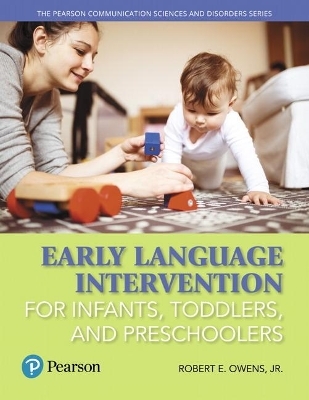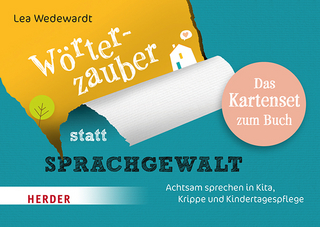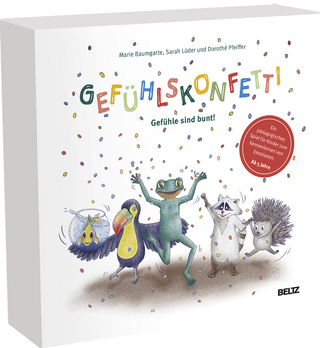
Early Language Intervention for Infants, Toddlers, and Preschoolers with Enhanced Pearson eText -- Access Card Package
Pearson
978-0-13-450968-6 (ISBN)
If purchasing or renting from companies other than Pearson, the access codes for the Enhanced Pearson eText may not be included, may be incorrect, or may be previously redeemed. Check with the seller before completing your purchase.
Early Language Intervention by Robert Owens is a comprehensive text on assessment and intervention with both verbal and nonverbal communication of infants, toddlers, and preschoolers. Informative and authoritative, it offers practical guidelines for functional methods that highlight language use within the daily routines of the home and classroom. Designed as an undergraduate-level text for communication disorders students, it covers assessment an intervention of both verbal and nonverbal communication, including augmentative and alternative communication (AAC), with young children who need support in learning to communicate. Also included are valuable resources, tables, and materials particularly useful for clinicians in practice.
Improve mastery and retention with the Enhanced Pearson eText*
The Enhanced Pearson eText provides a rich, interactive learning environment designed to improve student mastery of content. The Enhanced Pearson eText is:
Engaging. The new interactive, multimedia learning features were developed by the authors and other subject-matter experts to deepen and enrich the learning experience.
Convenient. Enjoy instant online access from your computer or download the Pearson eText App to read on or offline on your iPad® and Android® tablet.*
Affordable. Experience the advantages of the Enhanced Pearson eText along with all the benefits of print for 40% to 50% less than a print bound book.
*The Enhanced eText features are only available in the Pearson eText format. They are not available in third-party eTexts or downloads.
*The Pearson eText App is available on Google Play and in the App Store. It requires Android OS 3.1-4, a 7” or 10” tablet, or iPad iOS 5.0 or later.
0134509684 / 9780134300795 Early Language Intervention for Infants, Toddlers, and Preschoolers with Enhanced Pearson eText -- Access Card Package, 1e
Package consists of:
0134537734 / 9780134537733 Early Language Intervention for Infants, Toddlers, and Preschoolers, Enhanced Pearson eText -- Access Card, 1st Edition
0134618904 / 9780134618906 Early Language Intervention for Infants, Toddlers, and Preschoolers, Bound Book, 1st Edition
Robert E. Owens, Jr, PhD (“Dr. Bob”) is an Associate Professor at the College of St. Rose in Albany, NY and a New York State Distinguished Teaching Professor. He holds the American Speech-Language-Hearing Association Honors of the Association. His teaching includes language development and language disorders courses and is the author of Language Development, An Introduction (9 editions) with Pearson, Language Disorders, A Functional Approach (6 editions), Program for the Acquisition of Language with the Severely Impaired (PALS), Help Your Baby Talk, Introducing the New Shared Communication Method, and Queer Kids, The Challenge & Promise for Lesbian, Gay & Bisexual Youth. His Language Development text is the most widely used in the world and has been translated into Spanish, Korean, and Arabic. He has also co-authored Introduction to Communication Disorders, A Life Span Perspective (4 editions) with Pearson, written a score of book chapters and professional articles, and authored two as-yet unpublished novels which are sure to win a posthumous Pulitzer prize. In love with the sound of his own voice, Dr. Bob has presented over 200 professional papers and workshops around the globe. His professional interests are language disorders in infants, toddlers, and preschoolers who are also some of his best friends.
BRIEF TABLE OF CONTENTS
Chapter 1: Components of Early Intervention
Chapter 2: Early Communication Impairment
Chapter 3: A Model for Early Communication Intervention
Chapter 4: Assessment of Early Communication Intervention: What to Assess
Chapter 5: Early Communication Assessment Process
Chapter 6: Presymbolic Early Communication Intervention
Chapter 7: Alternative and Augmentative Communication: Introduction and Assessment
Chapter 8: Alternative and Augmentative Communication: Intervention
Chapter 9: Symbolic Intervention
Chapter 10: Feeding and Swallowing by Jessica Kisenwether, Ph.D., Misericordia University
Appendix A: Sample IFSP
Appendix B: Evaluation of At-Risk Neonates
Appendix C: Formal Tests for Young Children
Appendix D: Caregiver Questionnaire
Appendix E: Developmental Milestones
Appendix F: Interactional Observation
Appendix G: Forms of Communication
Appendix H: Intervention Approaches for Children with ASD
Appendix I: Stimulation Activities
Appendix J: Possible Electronic AAC Assessment Protocol
Appendix K: Feeding Assessment Interview Questionnaire
DETAILED TABLE OF CONTENTS
Chapter 1: Components of Early Intervention
Overview of EI
Legal Basis for Early Intervention
Education of the Handicapped Act Amendments
Individuals with Disabilities Education Act (IDEA)
Individuals with Disabilities Education Improvement Act (IDEIA)
Summary
Transdisciplinary Team
The Importance of Families
Cultural Considerations
Parents/Caregivers
Individualized for Each Child
Individualized Family Service Plan (IFSP)
Natural Environment
The Need for Evidence-Based Practice
Chapter Conclusion
Chapter 2: Early Communication Impairment
Late Language Emergence
Risk of Communication Impairment
Established risk
Intellectual Disability (ID)
Autism Spectrum Disorder (ASD)
Cerebral Palsy
Deafness and Deaf-Blindness
Cleft Palate
At-risk Children
International Adoptions
Low Socioeconomic Status
Maltreatment/Neglect, Fetal Alcohol Spectrum Disorder and Prenatal Cocaine Exposure
Preterm and Low Birth Weight Infants
Early Identifying Signs and Behaviors
APGAR, an Infant’s First Exam
Chapter Conclusion
Chapter 3: A Model for Early Communication Intervention
The Evolving Model of ECI Service Delivery
Functional Communication
Generalization
Family-Centered Intervention
Individualization
Conclusion
Content for Improving Communication
Intervention Strategies
Responsive Interaction Strategies
Directive Interaction Strategies
Blended Strategies
Role of a Child’s Environment
Family-Centered Services
Working with Parents
A Hybrid Approach to Family-Centered Intervention
Teachers, Classroom Aides, and Child Care Providers
Child Peers
Role of the SLP as Part of the Team
Consultation
Service Coordination
Transition Planning
Advocacy Awareness and Advancement of the Knowledge Base
An Example of Early Intervention: Parents Interacting with Infants (PIWI)
Chapter Conclusion
Chapter 4: Assessment of Early Communication Intervention: What to Assess
Evaluation vs. Assessment
Transdisciplinary Model of Assessment
Play-based Assessment
Conclusion
Role of Parents & Caregivers
A Rationale for Parental Involvement in Assessment
Involving Families in Assessment
Family Concerns, Priorities, and Resources
Informal Communication Assessment
Description of Communication
Presymbolic Behaviors
Symbolic Behaviors
Formal Assessment Infants, Toddlers, and Preschoolers
Early identification of Children with ASD
Eligibility for Services
Chapter Conclusion
Chapter 5: Early Communication Assessment Process
Communication Screening
Families with Culturally Linguistically Diverse Backgrounds
Communication Assessment
Multiple Measures
Transdisciplinary Teams
Ecological Validity
Pre-assessment Planning and Preliminary Data Collecting
Questionnaire
Caregiver Interview
The Evolving Assessment Plan
Interactional Observation
The Observation Process
Judging Communication Success and Intentionality
Caregiver-Child Interactions
Forming Hypotheses
Play-based Interactional Assessment
Dynamic Assessment
Describing Communication
Symbolic Assessment
Presymbolic Behaviors
Sampling
Analysis of Data
Decision-making and Recommendations
Outcomes
A Final Word on Parental Involvement
Special Cases
Children with Deafness and Blindness
International Adoptees and Children from Families Speaking Other-than-English
Children with Challenging Behaviors
Children with Motor Speech Disorders
Children with ASD
Chapter Conclusion
Chapter 6: Presymbolic Early Communication Intervention
Spectrum of Early Communication Intervention
Location of Intervention
Types of ECI Service Delivery
Intervention Approach
Evidence-Based Practice (EBP)
AAC and the Pressure to Speak
Contingent Imitation
Exaggerated Intonation and Modified Prosody
Feedback
Avoidance of Non-speech Oral Motor Exercises
Getting Started
Enhancing Communication
In the NICU or SCN
Establishing Early Communication
Functional Equivalence and Challenging Behaviors
Establishing Gestures
Vocalizing
Language Stimulation: Talking to Young Children
Bilingual Families
Presymbolic Skills
Establishing Joint Attending
Imitation
Means-Ends
Monitoring Intervention Chapter Conclusion
Chapter 7: Alternative and Augmentative Communication: Introduction and Assessment
Types of AAC
Unaided AAC
Aided AAC
Evidence-Based Practice
Dangers in Ignoring EBP
AAC Myths
Assessment
Elements of a Thorough AAC Assessment
Decision-making
Chapter Conclusion
Chapter 8: Alternative and Augmentative Communication: Intervention
Getting Started
Initiating Communication
Active Learning
Child-based Intervention
Representations
Organization
Selection
Output
The Child’s Communication System
Issues
Functional Equivalence
Vocabulary
Multimodality and Development
Generalization: Role of the Environment
Neuromotor Considerations
Intervention Methods
Early Communication Intentions
Transitioning from Nonsymbolic to Symbolic
Receptive Use
Expressive Use
Children with Deafness and Blindness
Children with ASD
Aided AAC
Picture Exchange System (PECS)
Chapter Conclusion
Useful Websites
Chapter 9: Symbolic Intervention
Early Symbolic Guidelines
Selecting New Symbols
Expanding the Range of Intentions
Teaching Semantic Categories
Combining into Longer Utterances
Symbolic Intervention Techniques
Model Language but Do Not Require a Child Response
Model Language and Require a Child Response
Provide Feedback but Do Not Require a Child Response
Respond and Require a Child Response
Specific Targets
Single Words
Two-Word Constructions
Longer Constructions
Involving Parents, Teachers, and Other Adults
Book Sharing
Language Modeling
A Helpful Website
Two Examples of Early Communication Intervention
Hanen Early Language Program
Responsive Education and Prelinguistic Milieu Teaching
Chapter Conclusion
Chapter 10: Feeding and Swallowing
by Jessica Kisenwether, Ph.D., Misericordia University
Background
Role of the SLP
Specific Considerations in Pediatric Swallowing
Differences in Anatomy and Physiology
Differences in Etiology
Differences in Communication Skills
Differences in Treatment
Development of Feeding
Newborns - 3 Months
6 - 12 Months
15 - 24 Months
Causes of Feeding/Swallowing Difficulty
Prematurity and/or Low Birth Weight
Neurological Conditions
Cardiovascular Conditions
Respiratory Conditions
Traumatic Brain Injury
Failure to Thrive
Esophageal Complications
Craniofacial Anomalies
Environmental Conditions
Feeding Team
Assessment Strategies
Medical History
Interview
Observation
Physical Examination
Swallow Evaluation
Instrumental Evaluation
Treatment Strategies
Environment
Positioning
Pacing
Texture Changes
Oral Motor/Sensory Stimulation
Behavioral Treatment
Cultural Considerations
Chapter Conclusion
Appendices
Appendix A: Sample IFSP
Appendix B: Evaluation of At-Risk Neonates
Appendix C: Formal Tests for Young Children
Appendix D: Caregiver Questionnaire
Appendix E: Developmental Milestones
Appendix F: Interactional Observation
Appendix G: Forms of Communication
Appendix H: Intervention Approaches for Children with ASD
Appendix I: Stimulation Activities
Appendix J: Possible Electronic AAC Assessment Protocol
Appendix K: Feeding Assessment Interview Questionnaire
Glossary
Author Index
Content Index
| Erscheint lt. Verlag | 22.2.2017 |
|---|---|
| Sprache | englisch |
| Maße | 100 x 100 mm |
| Gewicht | 100 g |
| Themenwelt | Geisteswissenschaften ► Psychologie ► Entwicklungspsychologie |
| Medizin / Pharmazie ► Gesundheitsfachberufe ► Logopädie | |
| Medizin / Pharmazie ► Medizinische Fachgebiete ► Pädiatrie | |
| Sozialwissenschaften ► Pädagogik | |
| ISBN-10 | 0-13-450968-4 / 0134509684 |
| ISBN-13 | 978-0-13-450968-6 / 9780134509686 |
| Zustand | Neuware |
| Haben Sie eine Frage zum Produkt? |
aus dem Bereich


